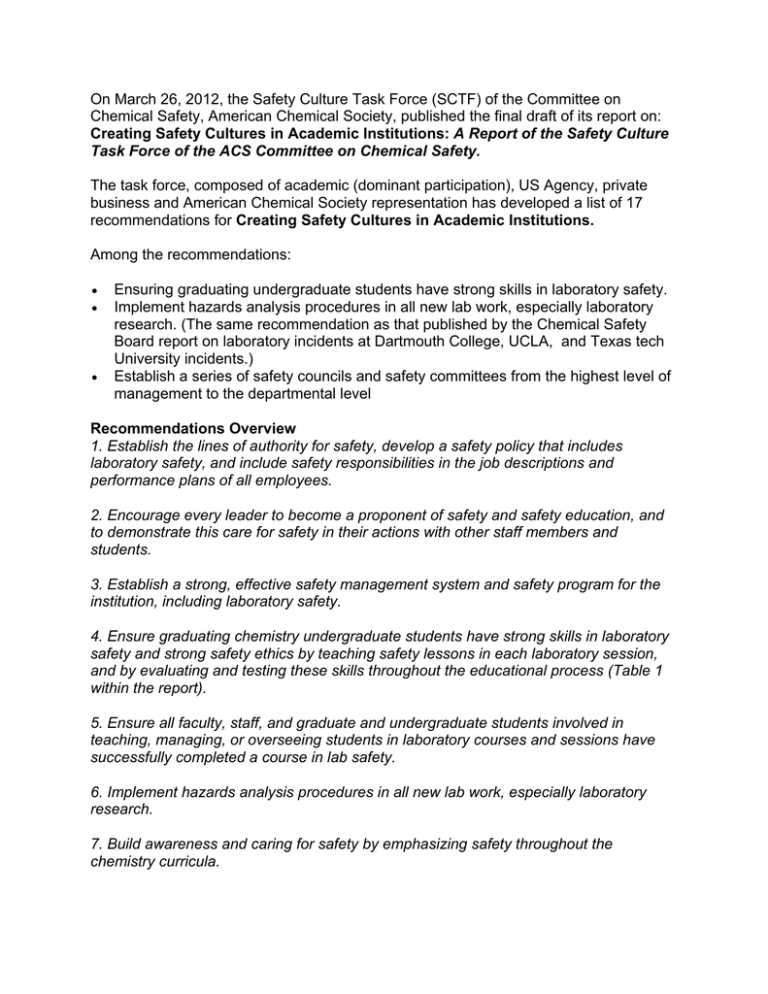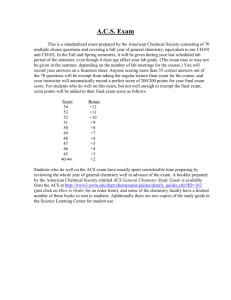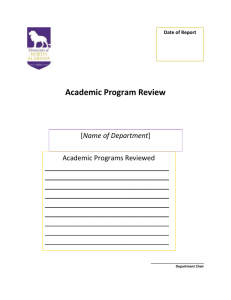On March 26, 2012, the Safety Culture Task Force (SCTF)... Chemical Safety, American Chemical Society, published the final draft of...
advertisement

On March 26, 2012, the Safety Culture Task Force (SCTF) of the Committee on Chemical Safety, American Chemical Society, published the final draft of its report on: Creating Safety Cultures in Academic Institutions: A Report of the Safety Culture Task Force of the ACS Committee on Chemical Safety. The task force, composed of academic (dominant participation), US Agency, private business and American Chemical Society representation has developed a list of 17 recommendations for Creating Safety Cultures in Academic Institutions. Among the recommendations: Ensuring graduating undergraduate students have strong skills in laboratory safety. Implement hazards analysis procedures in all new lab work, especially laboratory research. (The same recommendation as that published by the Chemical Safety Board report on laboratory incidents at Dartmouth College, UCLA, and Texas tech University incidents.) Establish a series of safety councils and safety committees from the highest level of management to the departmental level Recommendations Overview 1. Establish the lines of authority for safety, develop a safety policy that includes laboratory safety, and include safety responsibilities in the job descriptions and performance plans of all employees. 2. Encourage every leader to become a proponent of safety and safety education, and to demonstrate this care for safety in their actions with other staff members and students. 3. Establish a strong, effective safety management system and safety program for the institution, including laboratory safety. 4. Ensure graduating chemistry undergraduate students have strong skills in laboratory safety and strong safety ethics by teaching safety lessons in each laboratory session, and by evaluating and testing these skills throughout the educational process (Table 1 within the report). 5. Ensure all faculty, staff, and graduate and undergraduate students involved in teaching, managing, or overseeing students in laboratory courses and sessions have successfully completed a course in lab safety. 6. Implement hazards analysis procedures in all new lab work, especially laboratory research. 7. Build awareness and caring for safety by emphasizing safety throughout the chemistry curricula. 8. In the preparation of grant proposal, researchers should include in their plans safety education and training (for undergraduate students, graduate students, and postdoctoral scholars participating in proposed research) and oversight of research for safety. 9. Adopt a personal credo: the “Safety Ethic”—value safety, work safely, prevent at-risk behavior, promote safety, and accept responsibility for safety. 10. Establish and maintain an Incident Reporting System, an Incident Investigation System, and an Incident Database that includes not only employees, but students also—undergraduates, graduate students, postdoctoral scholars, and other nonemployees. 11. Establish an internal review process of incidents and corrective actions with the Departmental Safety Committee (faculty, staff, students, graduate students, and postdoctoral scholars), and provided periodic safety seminars on lessons learned from incidents. 12. Publish or share the stories of incidents and the lessons learned (case studies) to an institution’s website, a public website or an appropriate journal where students and colleagues from other institutions may also use these as case studies for learning more about safety. 13. Establish a series of safety councils and safety committees from the highest level of management to the departmental level or lower. Each of these committees reports, in turn, to a committee that is higher in the hierarchy of the institution. 14. Establish a close working relationship with EHS personnel at every departmental level seeking their advice and experience in safety and offering departmental and faculty advice to EHS based upon their experience with knowledge of chemistry. 15. Establish a close working relationship with local emergency responders so they are prepared to respond to emergencies in laboratories. 16. Establish a system to promote safety in an institution or department that encompasses: electronic communications; printed materials; special seminars or events discussing or promoting safety; a recognition system for good safety performance; and a process to solicit, review, and act on suggestions for improving safety and identifying safety issues. 17. Identify the ongoing need to support a strong safety culture and work with administrators and departmental chairs to establish a baseline budget to support safety activities on an annual basis. “Academic Safety Culture Report.” ACS Chemistry for Life. 10 April 2012. <http://portal.acs.org/portal/acs/corg/content?_nfpb=true&_pageLabel=PP_TRANSITIONMAIN&node_id= 2228&use_sec=false&sec_url_var=region1&__uuid=083dc3de-0678-44ff-88b3-e66ea3a69537>


